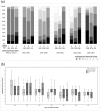Estimation of the Undiagnosed Intervals of HIV-Infected Individuals by a Modified Back-Calculation Method for Reconstructing the Epidemic Curves
- PMID: 27403882
- PMCID: PMC4942036
- DOI: 10.1371/journal.pone.0159021
Estimation of the Undiagnosed Intervals of HIV-Infected Individuals by a Modified Back-Calculation Method for Reconstructing the Epidemic Curves
Abstract
Background: Undiagnosed infections accounted for the hidden proportion of HIV cases that have escaped from public health surveillance. To assess the population risk of HIV transmission, we estimated the undiagnosed interval of each known infection for constructing the HIV incidence curves.
Methods: We used modified back-calculation methods to estimate the seroconversion year for each diagnosed patient attending any one of the 3 HIV specialist clinics in Hong Kong. Three approaches were used, depending on the adequacy of CD4 data: (A) estimating one's pre-treatment CD4 depletion rate in multilevel model;(B) projecting one's seroconversion year by referencing seroconverters' CD4 depletion rate; or (C) projecting from the distribution of estimated undiagnosed intervals in (B). Factors associated with long undiagnosed interval (>2 years) were examined in univariate analyses. Epidemic curves constructed from estimated seroconversion data were evaluated by modes of transmission.
Results: Between 1991 and 2010, a total of 3695 adult HIV patients were diagnosed. The undiagnosed intervals were derived from method (A) (28%), (B) (61%) and (C) (11%) respectively. The intervals ranged from 0 to 10 years, and were shortened from 2001. Heterosexual infection, female, Chinese and age >64 at diagnosis were associated with long undiagnosed interval. Overall, the peaks of the new incidence curves were reached 4-6 years ahead of reported diagnoses, while their contours varied by mode of transmission. Characteristically, the epidemic growth of heterosexual male and female declined after 1998 with slight rebound in 2004-2006, but that of MSM continued to rise after 1998.
Conclusions: By determining the time of seroconversion, HIV epidemic curves could be reconstructed from clinical data to better illustrate the trends of new infections. With the increasing coverage of antiretroviral therapy, the undiagnosed interval can add to the measures for assessing HIV transmission risk in the population.
Conflict of interest statement
Figures



Similar articles
-
Estimating HIV Incidence, Time to Diagnosis, and the Undiagnosed HIV Epidemic Using Routine Surveillance Data.Epidemiology. 2015 Sep;26(5):653-60. doi: 10.1097/EDE.0000000000000324. Epidemiology. 2015. PMID: 26214334 Free PMC article.
-
The undiagnosed HIV epidemic in France and its implications for HIV screening strategies.AIDS. 2014 Jul 31;28(12):1797-804. doi: 10.1097/QAD.0000000000000270. AIDS. 2014. PMID: 24681416 Free PMC article.
-
Use of surveillance data on HIV diagnoses with HIV-related symptoms to estimate the number of people living with undiagnosed HIV in need of antiretroviral therapy.PLoS One. 2015 Mar 13;10(3):e0121992. doi: 10.1371/journal.pone.0121992. eCollection 2015. PLoS One. 2015. PMID: 25768925 Free PMC article.
-
Estimating the First 90 of the UNAIDS 90-90-90 Goal: A Review.J Int Assoc Provid AIDS Care. 2020 Jan-Dec;19:2325958220919290. doi: 10.1177/2325958220919290. J Int Assoc Provid AIDS Care. 2020. PMID: 32351155 Free PMC article. Review.
-
Modeling methods for estimating HIV incidence: a mathematical review.Theor Biol Med Model. 2020 Jan 22;17(1):1. doi: 10.1186/s12976-019-0118-0. Theor Biol Med Model. 2020. PMID: 31964392 Free PMC article. Review.
Cited by
-
Estimation of time of HIV seroconversion using a modified CD4 depletion model.PLoS One. 2021 Feb 12;16(2):e0246135. doi: 10.1371/journal.pone.0246135. eCollection 2021. PLoS One. 2021. PMID: 33577551 Free PMC article.
-
HIV testing uptake and yield among sexual partners of HIV-positive men who have sex with men in Zhejiang Province, China, 2014-2016: A cross-sectional pilot study of a choice-based partner tracing and testing package.PLoS One. 2020 Jun 4;15(6):e0232268. doi: 10.1371/journal.pone.0232268. eCollection 2020. PLoS One. 2020. PMID: 32497114 Free PMC article.
-
Incorporation of information diffusion model for enhancing analyses in HIV molecular surveillance.Emerg Microbes Infect. 2020 Jan 30;9(1):256-262. doi: 10.1080/22221751.2020.1718554. eCollection 2020. Emerg Microbes Infect. 2020. PMID: 31997717 Free PMC article.
-
The Continuing Value of CD4 Cell Count Monitoring for Differential HIV Care and Surveillance.JMIR Public Health Surveill. 2019 Mar 20;5(1):e11136. doi: 10.2196/11136. JMIR Public Health Surveill. 2019. PMID: 30892272 Free PMC article.
-
HIV-1 Viral Loads Are Not Elevated in Individuals Co-infected With Schistosoma spp. After Adjustment for Duration of HIV-1 Infection.Front Immunol. 2018 Sep 6;9:2005. doi: 10.3389/fimmu.2018.02005. eCollection 2018. Front Immunol. 2018. PMID: 30237799 Free PMC article.
References
-
- Marks G, Crepaz N, Senterfitt JW, Janssen RS. Meta-analysis of high-risk sexual behavior in persons aware and unaware they are infected with HIV in the United States: implications for HIV prevention programs. Journal of Acquired Immune Deficiency Syndromes (1999). 2005;39:446–53. - PubMed
-
- Cohen MS, Chen Y, McCauley M, Gamble T, Hosseinipour MC, Kumarasamy N, et al. Final results of the HPTN 052 randomized controlled trial: antiretroviral therapy prevents HIV transmission. IAS 2015. 8th Conference on HIV Pathogenesis, Treatment and Prevention; July 19–22; Vancouver, Canada2015. p. 9.
-
- Brookmeyer R, Gail MH. Minimum size of the acquired immunodeficiency syndrome (AIDS) epidemic in the United States. Lancet. 1986;2(8519):1320–2. . - PubMed
MeSH terms
Grants and funding
LinkOut - more resources
Full Text Sources
Other Literature Sources
Medical
Research Materials

